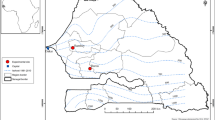Summary
Two ‘Bell’ pepper F1 hybrids demonstrated a significant advantage over open-pollinated varieties under growing conditions of suboptimal temperatures. Both hybrids gave significantly higher marketable yields than most of the varieties compared with them.
Early total yields were also significantly higher in both hybrids. Hybrid No 12 was significantly higher than all the other varieties in both early and overall marketable yields.
Two experimental hybrids produced by the use of ms 1 and ms 2 genes were found to be as promising as the regular hybrids.
Similar content being viewed by others
References
Daskaloff S., 1968. A male sterile pepper (C. annuum L.) mutant. Theor. appl. Genet. 38: 370–372.
Daskaloff S., 1971. Two new male sterile pepper (Capsicum annuum L.) mutants. C.r. Acad. Sci. agric. Bulg. 4 (3): 291–294.
Tadahiko Hirose, 1965. Fundamental study of the crossing of pepper. Tech. Bull. Fac. Agric. Kyoto. 2: 1–85.
Peterson P. A., 1958. Cytoplasmically inherited male sterility in Capsicum. Am. Nat. 92: 111–119.
Pochard E., 1966. Experimental data on the selection of Bell pepper (Capsicum annuum L.) Ann. Amelior. Pl. 16 (2): 185–197. (French).
Pochard, E., 1970. Obtention de trois nouvelles mutations de stérilité male chez le piment (Capsicum annuum L.) par traitements mutagènes appliqués à un matériel monoploide. Meeting on Male Sterility in Horticulture (June 1970, Versailles).
Rylski, Irena, 1971. Investigations on the influence of suboptimal temperatures on the flowering, 0 fruit setting and development of sweet pepper (Capsicum annuum L.). Ph. D. thesis, Hebrew University of Jerusalem, Israel. (Hebrew, English summary).
Shifriss C. & R.Frankel, 1969. A new male sterility gene in Capsicum annuum L. J. Am. Soc. hort. Sci. 94 (4): 385–387.
Shifriss C. & R.Frankel, 1971. New sources of cytoplasmic male sterility in cultivated peppers. J. Hered. 62 (4): 254–256.
Shifriss C. & I.Rylski, 1972. A male sterile (ms-2) gene in ‘California Wonder’ pepper (Capsicum annuum L.). Hort. Science 7 (1): 36.
Author information
Authors and Affiliations
Additional information
Contribution from the Agricultural Research Organization, The Volcani Center, Bet Dagan, Israel. 1972 Series, No 2245E.
Rights and permissions
About this article
Cite this article
Shifriss, C., Rylski, I. Comparative performance of F1 hybrids and open-pollinated ‘Bell’ pepper varieties (Capsicum annuum L.) under suboptimal temperature regimes. Euphytica 22, 530–534 (1973). https://doi.org/10.1007/BF00036652
Received:
Issue Date:
DOI: https://doi.org/10.1007/BF00036652




